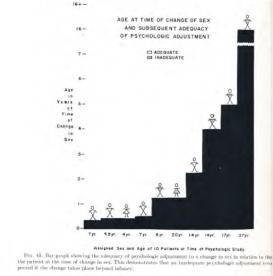The concept of “gender role” was coined in the early 1950s at the Johns Hopkins Hospital in Baltimore, MD. In a set of five publications, co-authored with psychiatrists Joan Hampson and her husband John Hampson and published between 1955 and 1956 in the Bulletin of the Johns Hopkins Hospital, John Money developed a new theory of human sexual development. Money and the Hampsons compared contradicting biological variables of sex and the sex the child had been assigned at birth with its gender role. They continued to propose that a patient’s gender role depended on the sex the child was raised in rather than on biological determinants alone. A person’s gender role grew cumulatively through life experiences encountered and transacted, they claimed. Based on this hypothesis, the team developed a set of treatment recommendations, which advocated early surgery on genitals to adjust the body to the assigned sex. The Hopkins protocols (as the five publications came to be called) became the dominant guidelines in intersex case management (ICM). Over the past two decades, intersex patient activists and gender scholars have, quite rightly, severely criticized these treatment practices for creating a world of shame, secrecy, and unwanted genital surgeries.
Sandra Eder's project shifted the focus of the story of gender. True, Money and the Hampsons developed their treatment recommendations to solve a general medical puzzle: In the case of conflicting biological sex variables, what was a person’s true sex? They did so, however, in the context of a specific clinical study of the introduction of cortisone as treatment for children, both boys and girls, with congenital adrenal hyperplasia (CAH). Their mission was to evaluate the psychological healthiness of children treated with cortisone for this serious condition. The initiator of this study, and the doctor who introduced the treatment with cortisone, was Lawson Wilkins, the head of the pediatric endocrinology clinic. Wilkins had helped establish the still young field of pediatric endocrinology and he became an expert on CAH. Not surprisingly, he was mostly interested in the metabolic effects of an adrenal pathology. Interested in sex he was not—at least not initially. Rather, it was his clinical practice, which also included children with “ambiguous” genitals or variations in sex development, next to children with what was then called “dwarfism,” with thyroid disorders, diabetes, and obesity, to name a just a few, that propelled him into the world of “hermaphroditism” and confronted him with the question of what the true sex of his patients might be. Thus, Lawson Wilkins and his clinic became the focus of my project.
Sandra Eder worked on a book manuscript, based on this research, that provides a historicized account of how the modern concept of gender was developed in mid-twentieth century American biomedicine. The book is both a study of how gender and sex were not just conceptualized but actually enacted within clinical practices, and a close look at how biomedicine works in practice, through the relationships among doctors, patients, and their families, social workers, nurses, psychologists, psychiatrists, and surgeons. Many layers of context, some of them having little to do with the determination of sex or the theorization of gender, are woven together to the fabric that is the story of gender. To foreground the background and to acknowledge that this story takes place in many sites and can be told from many perspectives enriches the story. These contexts include the doctors’ entire medical practice and the local clinical style (rather than just their ideas about gender); the notion of (biological) citizenship (how one is recognized as fully functioning and entitled member of society); disability and the experience of living with a chronic condition; the role of medical ethics and of the patient’s perspective in biomedicine; the history of childhood and the history of pediatrics; cultural scripts of masculinity and femininity; and scientific theories about sex determination.

